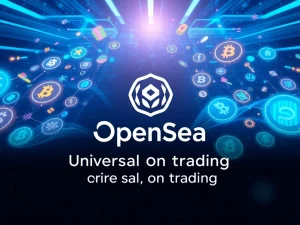Binance NFT Staking: Crucial Shift as BAYC & MAYC Programs End by August 2025

A significant development is shaking up the NFT landscape, particularly for holders of two of the most iconic digital collectibles: Bored Ape Yacht Club (BAYC) and Mutant Ape Yacht Club (MAYC) NFTs. Binance, a leading cryptocurrency exchange, has announced a major strategic shift, discontinuing its Binance NFT staking services for these popular collections. If you’ve been relying on passive income from your Apes, this update is crucial.
Binance NFT Staking: A Strategic Reassessment
Effective August 1, 2025, at 14:00 UTC, Binance NFT will cease its staking services for BAYC and MAYC NFTs. All staked NFTs will be returned to users’ accounts by August 3, 2025. This move marks a pivotal moment, signaling a broader re-evaluation of NFT offerings by centralized exchanges. The decision, as stated by Binance, is a direct result of adjustments in the underlying APE NFT staking mechanism. While the official rationale remains succinct, it opens up discussions about the evolving dynamics of NFT utility, liquidity, and platform-specific strategies.
For years, staking NFTs provided a compelling way for holders to earn rewards, adding an extra layer of utility beyond mere ownership. Binance’s decision reflects a growing trend where platforms are reassessing the long-term viability and strategic alignment of such programs amidst fluctuating market demand and evolving regulatory landscapes. This isn’t just a minor tweak; it’s a significant recalibration of how a major player like Binance approaches the NFT ecosystem.
What Does This Mean for BAYC NFT Staking Holders?
If you’re a holder of a Bored Ape Yacht Club NFT and have been participating in BAYC NFT staking on Binance, this announcement directly impacts your passive income strategy. The immediate consequence is the cessation of staking rewards. Historically, staking programs were designed to incentivize holding and reduce market supply, thereby potentially supporting floor prices. With this option removed, holders will need to consider alternative avenues for value extraction or utility.
Key Impacts for BAYC Holders:
- Loss of Passive Income: Staking rewards, often paid in ApeCoin (APE), will no longer be generated through Binance.
- Re-evaluation of Strategy: Holders might explore selling their NFTs, transferring them to decentralized staking platforms (if available), or seeking utility through metaverse integrations, gaming, or community initiatives.
- Potential Liquidity Shift: While the immediate impact on BAYC’s floor price is speculative, a shift in how these NFTs are held and utilized could influence their overall market dynamics.
The transition period, spanning just two days for NFT returns, provides limited time for preparation, raising some concerns about transparency regarding the lack of prior detailed communication about the reasons for this change. Users are now faced with the task of recalibrating their strategies in response to this platform adjustment.
Understanding the Impact on MAYC NFT Staking
Similar to their Bored Ape counterparts, Mutant Ape Yacht Club (MAYC) NFT holders who engaged in MAYC NFT staking on Binance will experience the same discontinuation of services. MAYC NFTs, often seen as an extension of the BAYC ecosystem, have also benefited from staking programs that offered rewards and encouraged long-term holding.
Considerations for MAYC Holders:
- Diminished Utility on Binance: The primary utility of staking on Binance will be removed, potentially altering how some holders perceive their MAYC NFTs within that specific ecosystem.
- Search for New Opportunities: Holders may now actively seek out other platforms or decentralized finance (DeFi) protocols that offer similar yield-generating opportunities for their NFTs.
- Community-Driven Alternatives: The strength of the Yuga Labs ecosystem often lies in its community. Holders might find new utility and engagement opportunities emerging from within the community itself, independent of centralized exchange offerings.
This move underscores the volatility inherent in centralized platform offerings. While convenient, they can pivot quickly, necessitating adaptability from users. The absence of replacement programs from Binance means holders are largely left to their own devices to find new avenues for their assets.
The Broader Picture: NFT Liquidity and Market Dynamics
Binance’s decision to discontinue these specific staking programs highlights a crucial aspect of the evolving NFT market: NFT liquidity. Staking mechanisms were initially introduced to enhance liquidity by offering incentives for holding, thereby potentially reducing immediate sell pressure. When a major platform removes such a mechanism, it naturally sparks questions about how this will affect the ease with which these high-value assets can be bought and sold.
Key Market Implications:
- Reassessment of Staking Models: This could prompt other centralized exchanges to re-evaluate their own NFT staking programs, potentially leading to a broader industry trend of scaling back or refining such offerings.
- Shift Towards Decentralization: The move might encourage more holders to explore decentralized platforms or self-custody solutions, where they have more control over their assets and their utility.
- Focus on Core Utility: Platforms may increasingly prioritize projects with intrinsic utility beyond staking rewards, such as those deeply integrated into gaming, metaverse experiences, or real-world applications. This could push the market towards more sustainable and use-case driven NFTs.
The NFT sector is continuously struggling with scalability and user retention. Platforms like Binance are prioritizing adaptability and sustainability amid shifting demand and technological advancements. This selective approach to project support reflects a maturing market where not all past models will remain viable.
APE NFT Staking Adjustments: What’s Next?
The primary reason cited for this discontinuation is “adjustments in the APE NFT staking mechanism.” ApeCoin (APE) is the native cryptocurrency of the ApeCoin DAO, and it plays a central role in the Yuga Labs ecosystem, including BAYC and MAYC. The staking mechanism for APE has seen various iterations and adjustments since its inception, aiming to balance rewards, tokenomics, and community engagement.
Potential Reasons for APE Staking Adjustments:
- Yield Sustainability: Maintaining high staking yields indefinitely can be unsustainable for a project’s tokenomics. Adjustments might be necessary to ensure the long-term health of the APE ecosystem.
- Decentralization Goals: The ApeCoin DAO might be moving towards a more decentralized staking model, reducing reliance on centralized exchanges for core staking functionalities.
- Evolving Utility: As the Yuga Labs ecosystem expands into new ventures like Otherside, the utility of APE and its associated NFTs might be shifting, requiring a re-alignment of staking incentives.
While Binance has not outlined replacement programs, this situation might accelerate the exploration of alternative use cases for BAYC and MAYC NFTs. Holders might look into:
- Metaverse Integration: Leveraging their NFTs within virtual worlds like Otherside.
- Gaming: Participating in blockchain-based games that integrate these NFTs.
- Lending Protocols: Using their NFTs as collateral on decentralized lending platforms.
- Community DAOs: Engaging more deeply with the ApeCoin DAO for governance and new initiatives.
The immediate impact on BAYC and MAYC valuations remains speculative without concrete data on user behavior post-cessation. However, historical shifts in staking mechanisms have often influenced market behavior, prompting users to recalibrate their strategies.
Conclusion: Navigating the Evolving NFT Landscape
Binance’s decision to discontinue Binance NFT staking for BAYC and MAYC NFTs by August 2025 is a powerful indicator of the dynamic and rapidly evolving nature of the NFT market. It underscores the challenges platforms face in balancing innovation with sustainability and highlights the ongoing re-evaluation of legacy staking models. For holders, this signals a need for increased adaptability and a proactive approach to managing their digital assets. While the immediate focus is on BAYC and MAYC, this move could set a precedent for how centralized exchanges engage with NFT staking going forward, potentially ushering in an era where utility and genuine ecosystem integration take precedence over passive yield generation.
As the NFT space matures, we can expect more strategic shifts from major players. Staying informed and exploring diverse avenues for NFT utility will be key for navigating this exciting yet unpredictable market. This is a reminder that in the world of digital assets, change is the only constant.
Frequently Asked Questions (FAQs)
1. Why is Binance discontinuing BAYC and MAYC NFT staking?
Binance announced the discontinuation due to “adjustments in the APE NFT staking mechanism” and a broader strategic shift in its NFT offerings. This reflects an industry trend where centralized exchanges are reassessing their NFT staking models amid fluctuating market demand and a focus on long-term sustainability.
2. When will the BAYC and MAYC NFT staking services end on Binance?
The staking services will officially cease on August 1, 2025, at 14:00 UTC. All staked NFTs will be returned to users’ accounts by August 3, 2025.
3. What should BAYC and MAYC NFT holders do after the staking ends?
Holders should explore alternative avenues for their NFTs, such as decentralized staking platforms (if available), leveraging their NFTs in metaverse games or experiences, participating in lending protocols, or engaging more deeply with the ApeCoin DAO for new utility and governance opportunities. Binance has not outlined replacement programs.
4. How will this affect the liquidity of BAYC and MAYC NFTs?
The discontinuation of staking on a major platform like Binance could impact the NFT liquidity of BAYC and MAYC by removing a key incentive for holding. While the immediate effect on valuations is speculative, it may encourage holders to explore alternative platforms or use cases, potentially shifting market dynamics.
5. Does this affect all NFT staking programs on Binance?
The announcement specifically mentions the discontinuation of staking services for Bored Ape Yacht Club (BAYC) and Mutant Ape Yacht Club (MAYC) NFTs. It signals a strategic reassessment of their NFT offerings, but does not explicitly state that all other NFT staking programs will be affected, though it suggests a broader trend of re-evaluation.









